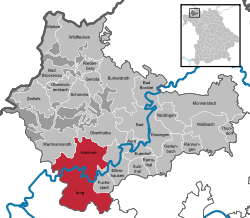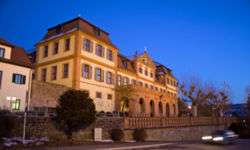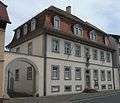Hammelburg
| Hammelburg | ||
|---|---|---|
| ||
 Hammelburg | ||
Location of Hammelburg within Bad Kissingen district  | ||
| Coordinates: 50°07′N 9°54′E / 50.117°N 9.900°ECoordinates: 50°07′N 9°54′E / 50.117°N 9.900°E | ||
| Country | Germany | |
| State | Bavaria | |
| Admin. region | Unterfranken | |
| District | Bad Kissingen | |
| Government | ||
| • Mayor | Ernst Stross (SPD/"Hammelburgs Aktive Bürger") | |
| Area | ||
| • Total | 128.89 km2 (49.76 sq mi) | |
| Elevation | 182 m (597 ft) | |
| Population (2015-12-31)[1] | ||
| • Total | 11,135 | |
| • Density | 86/km2 (220/sq mi) | |
| Time zone | CET/CEST (UTC+1/+2) | |
| Postal codes | 97762 | |
| Dialling codes | 09732 | |
| Vehicle registration | KG, BRK, HAB | |
| Website | www.hammelburg.de | |


Hammelburg is a town in the district of Bad Kissingen, in Lower Franconia, Bavaria, Germany. It lies on the river Franconian Saale, 25 km west of Schweinfurt. Hammelburg is the oldest winegrowing town (Weinstadt) in Franconia.
The Nazi Party placed Hammelburg in Gau Mainfranken. During World War II, Hammelburg was the site of the POW Camps OFLAG XIII-B and Stalag XIII-C, as well as the attempted rescue of POW's from these camps by Task Force Baum in 1945. The American television sitcom Hogan's Heroes (which ran on CBS from 1965 to 1971), featured a fictional Luft-Stalag 13, said to be near Hammelburg — the German Wehrmacht Heer-operated Stalag XIII-C POW camp was actually located in Hammelburg during World War II. The modern German Army's Infantry School (Infanterieschule) is located in this town.
The name Hammelburg is documented for the first time on 18 April 716 as Hamulo Castellum. At this time, the fortress (Castellum) in ducal possession was favorable to traffic because of the intersection of east-west and north-south export/import and traffic routes. As a Franconian possession in the year 777, Charlemagne donated Hammelburg with its entire municipal area to the charity of Saint Boniface. Saint Martin's Church (Martinskirche) had already been bequeathed in 741 by Carloman to the Bishopric of Würzburg, into lawful ownership of the monastery of Fulda. Hammelburg, because of its location at a ford on the Franconian Saale, was of strategic importance. Directly above the river bank, the Franconian royal court was developed over the hall bank. In the 12th century, Fulda built on the heights over on the Saale's left bank the castle of Saaleck for Hammelburg's protection, which particularly served for control of the Trimburg established by the Hennebergs. In 1234, Würzburg succeeded in appropriating the Trimburg from the Hennebergs. Fulda answered this by moving closer to the old opponent with the attachment of Hammelburg and to the stronger development of Saaleck Castle. In the year 1303, under King Albrecht, municipal rights were granted Hammelburg. The old attachment plant, those with walls and ditches that surrounded the city, had three gate towers (Weiher, Upper and Niedertower) and eleven military towers. From this time still exists the Guardian, Monk and Baderturm, a part of the southern city wall and the Schlossweiher received. The Hammelburger citizen had begun by selfinitiative in 1302 with the building of a church. This church of Maria (Marienkirche) at the cattle market became a symbol of civil self-sufficiency. The building of the parish church pc. Johannes in the old castle district the Hammelburger left to the national gentlemen. The Marienkirche fell victim to a fire in 1854, a fire which also destroyed several other parts of the city. The delighted gothic parish church (1389-1461) is today an object of historical interest. Despite the support of Fulda and Würzburg, Hammelburg changed very early to the Lutheran teachings and only by menace did the city return to the Catholic faith in 1604. 120 Protestant Hammelburger families left their hometown in this year because of it.

A few years later, a furious epidemic cost the city even more of its citizens. Because of the heavy losses of these years the city did not recover until the 18th century. From this blooming time of the 16th century, came the (1524-1526) city hall, a new building made in the Renaissance style, from the architect Johannes Schöner, (1529) where the first council meeting was held therein. Only the lateral stair tower and the city hall cellar remains today. The current city hall, built after the fire in the gothic style, was occupied on December 12, 1859. The Renaissance market well, which was completed in 1541, is likewise a work of the master builder Schöner. Up to the year 1803, Hammelburg belonged to Fulda. It came in the course of the secularization until 1806 at Oranien Naussau. Under Napoleon's brother-in-law, Marshal Murat, the city was (1806-1810) under French administration. In 1810, it assigned Hammelburg to the new Grand Duchy of Frankfurt. After a short Austrian affiliation, the city was integrated 1816 into the new State of Bavaria. In the years after the Second World War the total population of the city was increased by refugees from both Eastern Europe and Eastern Germany and starting from 1956 by the German Federal Armed Forces reorganization. Also in those years, the edge municipalities also saw a large increase in their population. The local reorganisation let the number of inhabitants rise in Hammelburg again. The former municipalities Westheim, Pfaffenhausen, Untererthal, Obererthal, Feuerthal, Morlesau, Obereschenbach with Untereschenbach and Gauaschach attached themselves to the city of Hammelburg, which thus counts approximately 12,500 inhabitants.
The oldest Franconian wine city can be reached extremely favorably by the motorway and has a rich variety of attractions. There are several numerous and partially very well received architectural monuments, cosy restaurants and hotels. The sports center contains outdoor and indoor swimming pools, indoor tennis courts, large-sport-resounds, a soccer stadium, the special landing area for aircraft, recreation sites and good hiking possibilities in variety landscapes of Südrhön and Saaletal-valley inviting tourists to stay. Its proximity to the Autobahn A7 make Hammelburg not only interesting but also as a strategic economic place.
 City walls
City walls St John the Baptist's Church
St John the Baptist's Church Rectory
Rectory St Michael's church
St Michael's church Cemetery
Cemetery Listed building
Listed building
References
- ↑ "Fortschreibung des Bevölkerungsstandes". Bayerisches Landesamt für Statistik und Datenverarbeitung (in German). June 2016.
External links
| Wikimedia Commons has media related to Hammelburg. |
